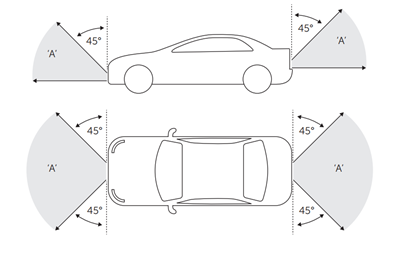Bicycle rack number plate rules
In Victoria, driving on a highway without securely fixed and
clearly displayed number plates is a $385 fine and will be penalised 3 demerit
points.
The use of rear bicycle racks and number plates must meet safety requirements so that:
- Number plates can be seen clearly at day and night when a rack means people can’t see the vehicle’s number plate.
- Vehicle brake and rear lights can be clearly detected by vehicles driving behind the bicycle rack.
- The bicycle rack itself is the right product for the specific vehicle and is safely installed on the car for driving and pedestrian safety.
Safety and visibility guidelines
Number plate visibility

- The rear number plate on a vehicle must be clearly visible from a distance of 20 metres at any angle within a 90 degree horizontal arc and a 45 degree vertical arc as shown in the diagram above.
- A bicycle rack number plate must be visible at night using sufficient lighting.
- Hand-drawn or printed plates are not sufficient. The plate must be issued by VicRoads. It is recommended you purchase a plate specifically intended for bicycle racks. You may alternatively unscrew your rear vehicle number plate and reattach each time you use your rear bicycle rack.
Vehicle rear visibility
- A bicycle rack must not obstruct the visibility of tail lights, parking lights, indicators or brake lights. Racks and bicycles must be repositioned to provide the best visibility.
- If it’s not possible to avoid obstructing lights on the rear of the car then portable lights should be fitted to the rear of the bicycle rack. It must be a pair of red lights visible for 200 metres behind the rear of the vehicle.
- Any Probationary plates or Learner’s plates must also be moved and displayed visibly if a bicycle rack is obstructing a clear view.
Pedestrian and bicycle safety
- Road safety regulations require that any object fitted to the vehicle in a way that minimises the likelihood of injury to any person making contact with the vehicle. Any sharp pieces of metal should be covered. Number plates should be surrounded by rubber or plastic.
Choosing a bicycle rack
- It’s important that when you choose a bicycle rack that it is suitable for your vehicle.
- You should always follow the manufacturer’s instructions for fitting, using and removing a rack.
- The bicycle rack must not carry more than the number of bicycles it is designed to hold.
- You must not exceed the maximum weight limit for any bike rack and the towbar of a vehicle
- The weight created by bicycles and racks attached to the vehicle as well as other loads including passengers must not exceed the vehicle’s gross mass
- Attaching a bicycle rack must not extend beyond the legal dimensions of a vehicle—4.3 metres in height, 2.5 metres in width.
- Rear bicycle racks must not exceed rear overhang limits—60% of the wheelbase or 3.7 metres, whichever is less.
- A bicycle rack must not protrude more than 150mm from the outermost side of either side of the vehicle.
- A bicycle rack should not protrude more than 1.2 metres beyond the rear of the vehicle. If it can’t be avoided a warning signal must be attached. During the day this should be a brightly coloured flag or material with each side at least 130mm long, and during the night a red light that can be seen by at least 200 metres.
Order your bike plate online